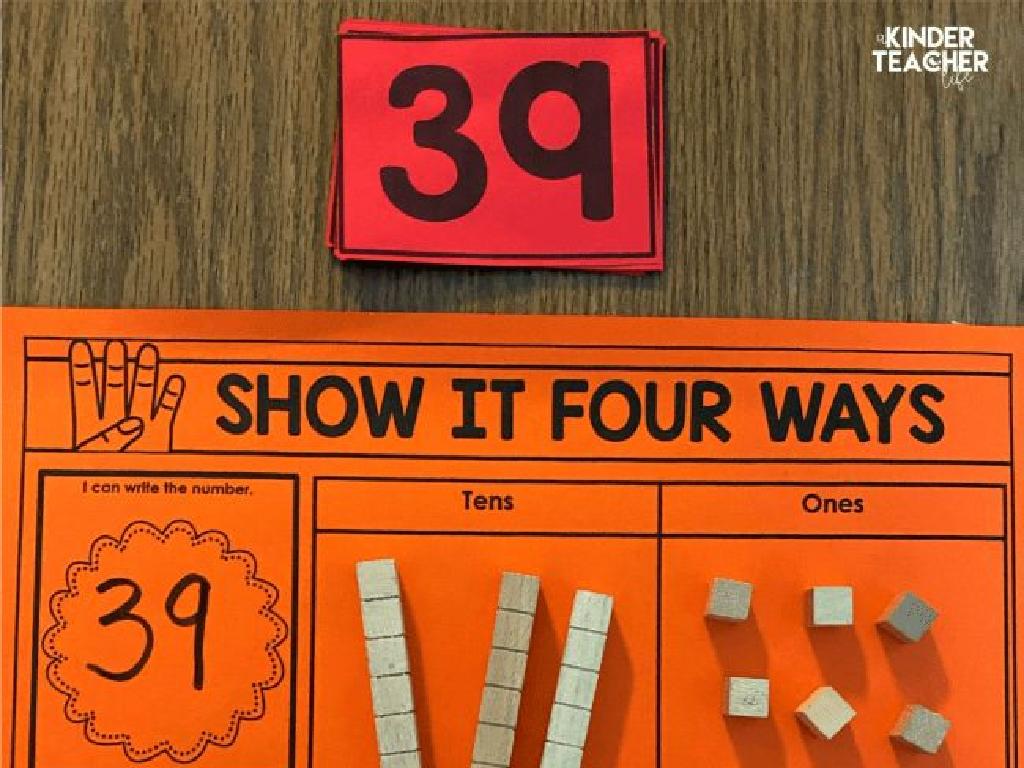Choose The Picture That Matches The Idiomatic Expression
Subject: Language arts
Grade: Third grade
Topic: Idioms
Please LOG IN to download the presentation. Access is available to registered users only.
View More Content
Introduction to Idioms
– What are idioms?
– Phrases with a meaning different from the words
– Why use idioms?
– To express ideas in a fun and creative way
– Examples of common idioms
– ‘Piece of cake’, ‘Break the ice’, ‘Let the cat out of the bag’
– Understanding idioms in pictures
– Matching idioms to the correct images helps us learn their meanings
|
This slide introduces the concept of idioms to third-grade students. Idioms are phrases where the words together have a different meaning than the individual words themselves. We use idioms to make our language more colorful and to express complex ideas in a simple way. Provide examples like ‘Piece of cake’ to mean something very easy, ‘Break the ice’ for starting a conversation, and ‘Let the cat out of the bag’ for revealing a secret. Explain that understanding idioms can be like solving a puzzle, and using pictures can make it easier and more fun to learn. Encourage students to think of idioms as special language codes that they can learn to understand and use.
Cracking the Code of Idioms
– Idioms: Not just literal words
– Phrases mean something different than the words by themselves
– Idioms make language exciting
– They add color to our conversations and writing
– Think of idioms as secret codes
– Understanding idioms is like solving a fun mystery in what we say
– Examples: ‘Piece of cake’, ‘Break a leg’
– ‘Piece of cake’ means something easy, ‘Break a leg’ means good luck
|
This slide introduces students to the concept of idioms, which are phrases that cannot be understood from the meanings of their individual words. They are used to add a playful and expressive layer to language. By comparing idioms to secret codes, it becomes an engaging challenge for students to decipher their meanings. Provide examples like ‘Piece of cake’ to illustrate an easy task, and ‘Break a leg’ to wish someone good luck. Encourage students to think of idioms as a fun way to communicate and to be detectives in figuring out what each idiom means. In the next class, we can have students draw or select pictures that they think match different idiomatic expressions.
Common Idioms and Their Meanings
– ‘Break the ice’ meaning
– To start a conversation in a group
– ‘Piece of cake’ is easy
– When a task is very easy to complete
– ‘Let the cat out of the bag’
– To accidentally reveal a secret
– Match idioms to pictures
|
This slide introduces students to common idiomatic expressions used in everyday language. ‘Break the ice’ refers to initiating conversation in a social setting, making people feel more comfortable. ‘Piece of cake’ is used when referring to a task that is very easy to accomplish. ‘Let the cat out of the bag’ means to reveal a secret, usually unintentionally. The activity will involve matching these idioms to appropriate pictures, which will help students remember the expressions and their meanings. Encourage students to discuss the idioms and use them in sentences. Prepare images that illustrate the literal interpretation of each idiom for the matching activity.
Match the Idiom!
– Let’s play a matching game
– I’ll show you an idiom
– An idiom is a phrase where the words together have a different meaning
– Choose the matching picture
– Look at the pictures and select the one that fits the idiom’s true meaning
– Think about the idiom’s meaning
– Remember, idioms don’t mean exactly what the words say!
|
This slide introduces a class activity focused on understanding idioms. Idioms are phrases where the words together have a special meaning different from the literal meanings of each word. The activity involves showing students an idiom and having them choose a picture that represents the idiom’s actual meaning. For example, ‘It’s raining cats and dogs’ could be matched with a picture of a heavy rainstorm, not pets falling from the sky. This exercise helps students to think critically about language and familiarizes them with common idiomatic expressions. As a teacher, prepare a set of idioms and corresponding pictures beforehand. Make sure the pictures are clear and the idioms are age-appropriate. During the activity, encourage discussion about why each picture was chosen and guide students towards the correct interpretation of each idiom.
Understanding Idioms: ‘Under the Weather’
– What does ‘Under the weather’ mean?
– It’s not about the rain!
– It means feeling unwell
– Think of times you didn’t feel good and had to stay in bed
– Let’s match the idiom to a picture
– We’ll choose between pictures to find the best match
|
This slide introduces the idiom ‘Under the weather’ to help students understand that idiomatic expressions don’t always mean what they literally say. Emphasize that ‘Under the weather’ is used when someone is feeling sick or ill, not when they are outside during bad weather. Encourage the students to think about how they feel when they’re sick to relate to the idiom. Then, proceed with an interactive activity where students will look at different pictures and choose the one that best represents someone being ‘under the weather’. This will help them connect the idiom to its figurative meaning and reinforce their understanding through visual association.
Practice Time: Matching Idioms to Pictures
– I’ll show you an idiom
– Think about the idiom’s true meaning
– Idioms often mean something different than the words by themselves
– Discuss with your partner
– Share ideas with your partner to figure it out
– Choose the picture that fits best
|
This slide is for a class activity where students will practice understanding idioms by matching them with the correct pictures. Display idioms one at a time and provide a selection of pictures for students to choose from. Encourage them to think beyond the literal meaning of the words and consider what the idiom is trying to convey. Students should work in pairs to foster discussion and collaboration, allowing them to benefit from each other’s insights. As they decide on the best match, they’ll develop a deeper understanding of idiomatic expressions. Possible idioms to use include ‘piece of cake’, ‘break the ice’, or ‘let the cat out of the bag’, with corresponding images that represent the idiomatic meaning.
Class Activity: Idiom Art Gallery
– Create a picture for a given idiom
– Express the idiom’s meaning through art
– Think about what the idiom means, not just the words
– Use your imagination and creativity
– Prepare to display your artwork
– Your art will be part of our class gallery
|
This activity is designed to help students understand idiomatic expressions by connecting them with visual art. Provide each student with an idiom and explain its meaning. Encourage them to think creatively about how to represent the figurative meaning of the idiom, rather than its literal words. Provide art supplies and let students’ imaginations run wild as they create their masterpieces. Once completed, organize a gallery walk where students can display their artwork and explain their interpretation of the idiom. This will reinforce their understanding of idioms and how they are used in language. Possible idioms to use include ‘Piece of cake’, ‘Break the ice’, or ‘Let the cat out of the bag’.
Review and Share: Idiom Artwork
– Review today’s idioms
– Present your idiom drawings
– Show the picture you drew that represents an idiom
– Guess classmates’ idioms
– Try to figure out the idioms from your friends’ artwork
– Discuss the meanings together
– Talk about what each idiom actually means
|
This slide is meant to wrap up the lesson on idioms. Start by revisiting the idioms discussed in the class to reinforce learning. Then, move on to a fun activity where students will share the artwork they created that represents different idioms. Encourage the class to guess which idiom each artwork represents, fostering a collaborative and interactive learning environment. This activity will help students better understand idiomatic expressions by associating them with visual representations. It’s also a great opportunity for students to practice their speaking and listening skills as they explain their artwork and guess others’. Make sure to praise their creativity and correct guesses, and gently guide them towards the right answers when necessary.
Becoming an Idiom Expert!
– Congratulations on learning Idioms!
– Spot Idioms in books and talks
– Look for phrases that don’t mean exactly what they say
– Find Idioms in movies too
– Listen for unusual phrases that paint a picture or express an idea
– Keep practicing your Idiom skills
|
This slide is meant to congratulate the students on their hard work learning about idioms. It’s important to encourage them to continue noticing idioms in their daily lives, such as in books, during conversations, and in movies. This will help them understand the context in which idioms are used and enhance their grasp of figurative language. Keep the momentum going by suggesting they practice with friends or family and by recognizing idioms in their favorite shows or stories. Celebrate their progress and remind them that with practice, they’ll become idiom experts. You can plan a fun activity where students bring in examples of idioms they find in their daily lives for extra credit.





